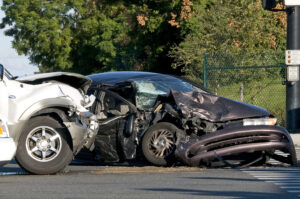Athens T-Bone Accident Lawyer
A T-bone accident occurs when one car crashes head-on into the side of another car, forming a “T” shape.
These accidents are extremely dangerous because there is less protection for occupants on the sides of the vehicle. A metal door and a glass window are usually all that stand between you and the front end of another vehicle.
If you were injured in a car crash like this, call an Athens T-bone accident lawyer at (706) 995-7547. Keep reading to learn more about fault, damages, and injuries in T-bone accidents.
How to Tell Who’s at Fault in a T-Bone Accident
To recover damages from your T-bone accident, you must prove that the accident and your injuries were someone else’s fault. In Georgia, fault is determined by a modified comparative negligence rule.
Essentially, you may file a lawsuit and attempt to recover compensation as long as you can prove that you were less than 50% to blame for the accident and your injuries.
If you are 50% or more at fault for the accident, then you cannot recover damages.
Additionally, your percentage of fault dictates how much compensation you can receive. So, if you were 10% at fault for the accident, then the compensation you are requesting can be decreased by 10%.
How do you know who was at fault and how much they were at fault? It will depend on the circumstances of your accident, but there are a few things to consider.
1. Who had the right of way.
You can’t always assume the car that crashed head-on into the side of another car is the one to blame in a T-bone accident.
If the driver with front damage was driving through an intersection with a green light, they have the right of way. If the driver with side damage was running a red light at the same time through that same intersection, they could get in the way and cause the other car to ram into their side.
In this scenario, the driver with side damage didn’t have the right of way and can be found to be mostly responsible for the accident.
2. Which side of the vehicle was damaged.
Although the right of way does matter, the accident assessors will still evaluate the damage on each of the vehicles, noting which side of the vehicle the damage is on.
Professionals who evaluate crash damage use this information to help reconstruct the accident and get a clearer idea of who was at fault.
3. Traffic laws were broken.
When proving fault, there needs to be negligence. A driver who broke traffic laws immediately has some negligence on their part.
If one car was running a red light or a stop sign, they may be deemed to be at fault. Likewise, a car who had the right of way but was driving under the influence may also assume some fault.
Potential Damages for T-Bone Victims
When you and your Athens T-Bone accident lawyer file a claim against the negligent driver, there are several potential types of damages you can sue for.
Damages are typically broken down into three categories: economic damages, non-economic damages, and punitive damages.
Economic Damages
Economic damages are the financial consequences of an accident or injury. Compensation for economic damages seeks to repay you for financial burdens that you have as a result of the T-bone accident.
Here are some examples of economic damages you may be able to recover:
- Current and future medical expenses: If you suffered an injury from your T-bone accident, your medical bills can start to add up. An ambulance ride, emergency room visits, primary care doctor’s appointments, specialists appointments, prescriptions, and physical therapy appointments are just a few of the many things you could be expected to pay for after your accident.
Even if you have health insurance, these things can cost a lot of money. If you have a severe injury that needs continued or long-term treatment, you will also have future medical bills to worry about.
- Property damage: If your car or any other property was damaged in a T-bone accident that was not your fault, you may be able to recover compensation for these losses.
- Lost wages: If you were injured in your accident, you could have to miss work for doctor’s appointments or may simply be unable to work for a while because of your injuries.
Missing any days of work at all can increase your financial stress. If you lost wages as a result of an accident that was not your fault, you could potentially recover compensation for that.
- Reduced earning capacity/loss of potential income: If you’re left severely injured or even permanently disabled after your car accident, you may not be able to work as much as before, do the same type of labor you used to, or even be able to return to the workforce at all. This can be a huge adjustment for many reasons, one of them being the financial strain it can cause on you and your household.
Losing a stream of income can be financially devastating, but you shouldn’t have to suffer because of an accident that you did not cause. You could recover economic damages for reduced earning capacity to help.
Non-Economic Damages
Non-economic damages are hardships that occur as a result of an accident or injury but are not strictly financial. By recovering non-economic damages, you can be compensated for more intangible negative consequences of the accident.
Here are some examples of non-economic damages you may be able to recover.
- Pain and suffering: The pain and suffering that accident injuries cause matters. Although financial compensation will not relieve the pain or erase the suffering, it’s important that you’re compensated for the hardships you have endured.
- Emotional distress and mental anguish: The distressing nature of car accidents and injuries can also cause mental health challenges. You should not have to suffer in silence after a traumatic accident.
Punitive Damages
Punitive damages aren’t very common in car accident cases but are sometimes awarded when the negligent party did something with intent, malice, or extremely dangerous recklessness. If the driver who caused your T-bone accident was super-speeding or driving under the influence, for example, you and your Athens T-bone accident lawyer could request punitive damages.
Injuries Can Be Serious in T-Bone Collisions
The person who was hit on the side of their car is especially vulnerable to injury, but drivers and passengers from either car can sustain serious or even life-threatening injuries.
Here are just a few of the types of injuries you could get from a T-bone car accident:
Head and Brain Injuries
Drivers and passengers in T-bone accidents can easily sustain head injuries from the impact of the crash, whether that is from hitting their head or from a concussion from the jolt of the collision.
Head injuries don’t have to be visible to change your life. For example, traumatic brain injuries where the skull was not penetrated can range in severity from a mild concussion to a permanent and severe disability.
Neck Injuries
The sudden impact of the crash can also cause neck injuries like whiplash. Whiplash occurs when the head is thrust suddenly forward and then backward. It can cause pain in the neck and shoulders and while many are mild, others can lead to permanent mobility issues.
Back Injuries
The trauma of a T-bone accident can cause injuries to the muscles, nerves, and vertebrae in the back. Injuries to the muscles in the back may result in soreness, pain, stiffness, and limited range of motion.
Nerve and vertebrae damage on the spinal cord could lead to partial or full paralysis depending on where the damage is, which can be a severe and permanent disability.
Ear Injuries and/or Trauma
Ear trauma is not usually the first thing people think of when they think about car accident injuries, but the noisy impact of a T-bone accident can cause ear trauma such as tinnitus, which is characterized by a near-constant ringing in one or both ears.
Don’t write off any ear pain or issues as normal after a car accident. An ear, nose, and throat specialist can check you for ear injuries.
Organ Damage and Internal Bleeding
One common example of organ damage is when occupants suffer punctured lungs from hitting the dashboard or even from deployed airbags.
Always get checked out by a doctor after a car accident, even if you’re feeling fine. Some injuries take a while to be noticeable, and early detection and treatment increase your chances of a full recovery.
Injured in a T-bone accident? We can help.
If you were injured in a T-bone accident, we want to help you. An Athens T-Bone accident lawyer can help you recover damages for the hardships you have endured as a result of another driver’s negligence.
Mike Rafi has years of experience getting justice for injured Georgians and will work hard to get you the maximum amount of compensation available. Call (706) 995-7547 today to schedule your free case consultation with the Athens car accident lawyer.




